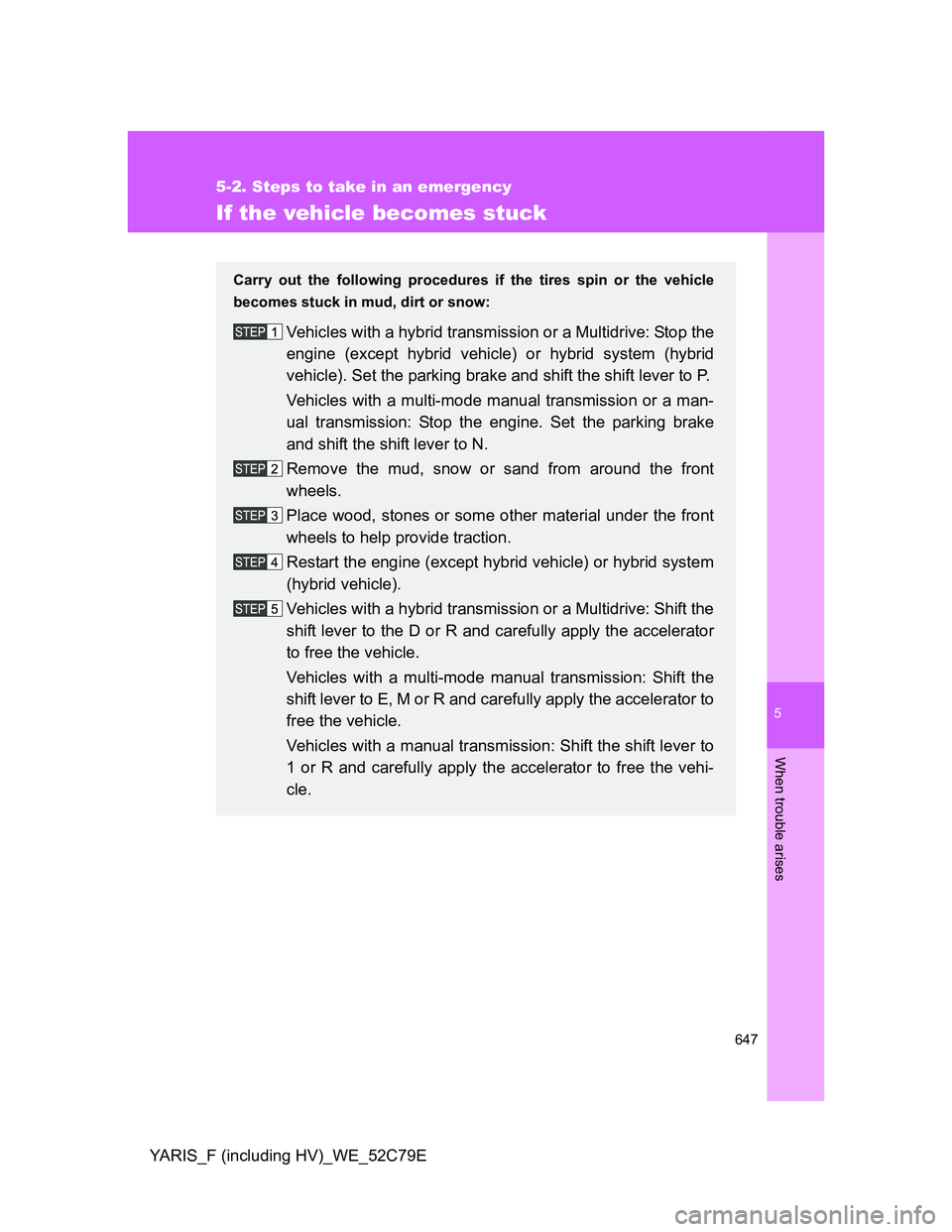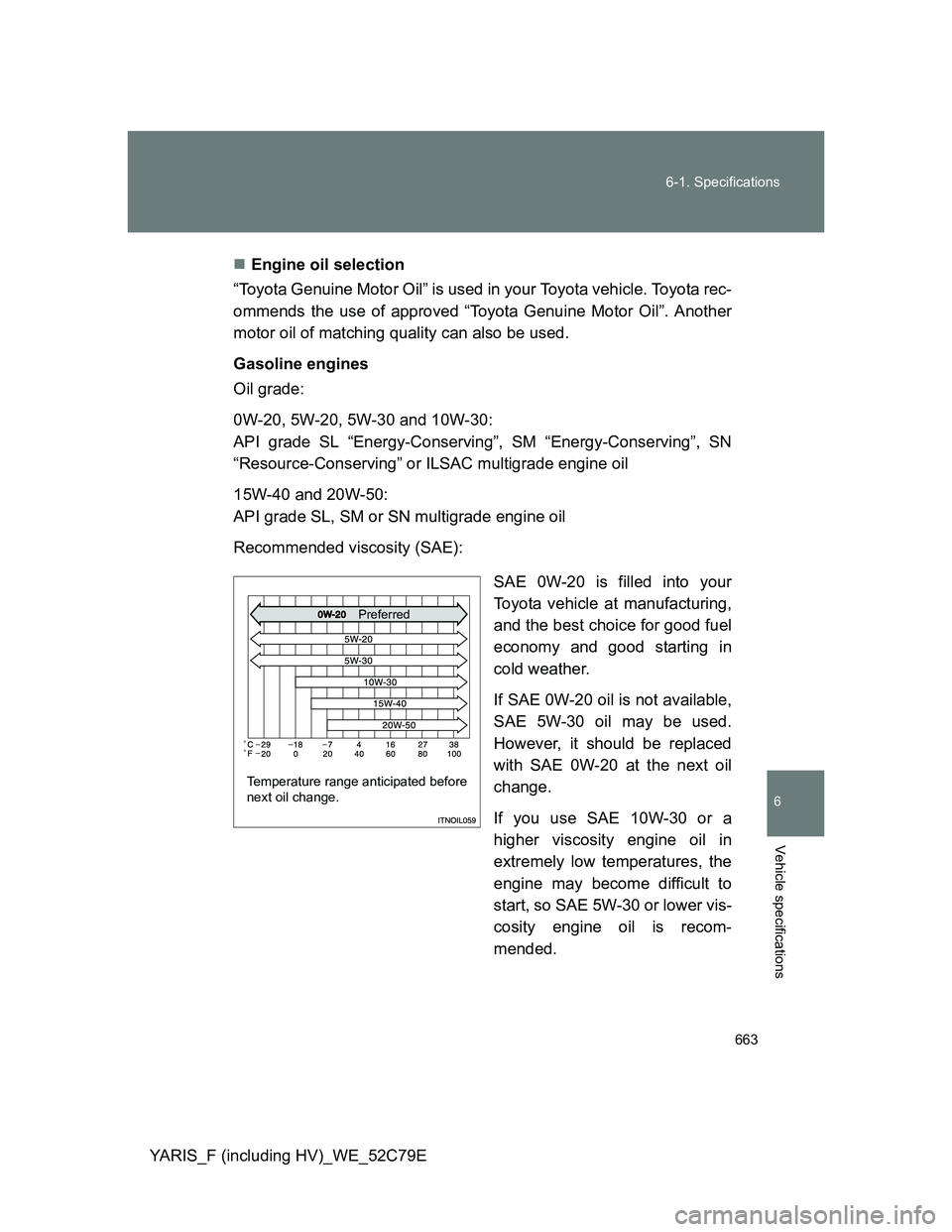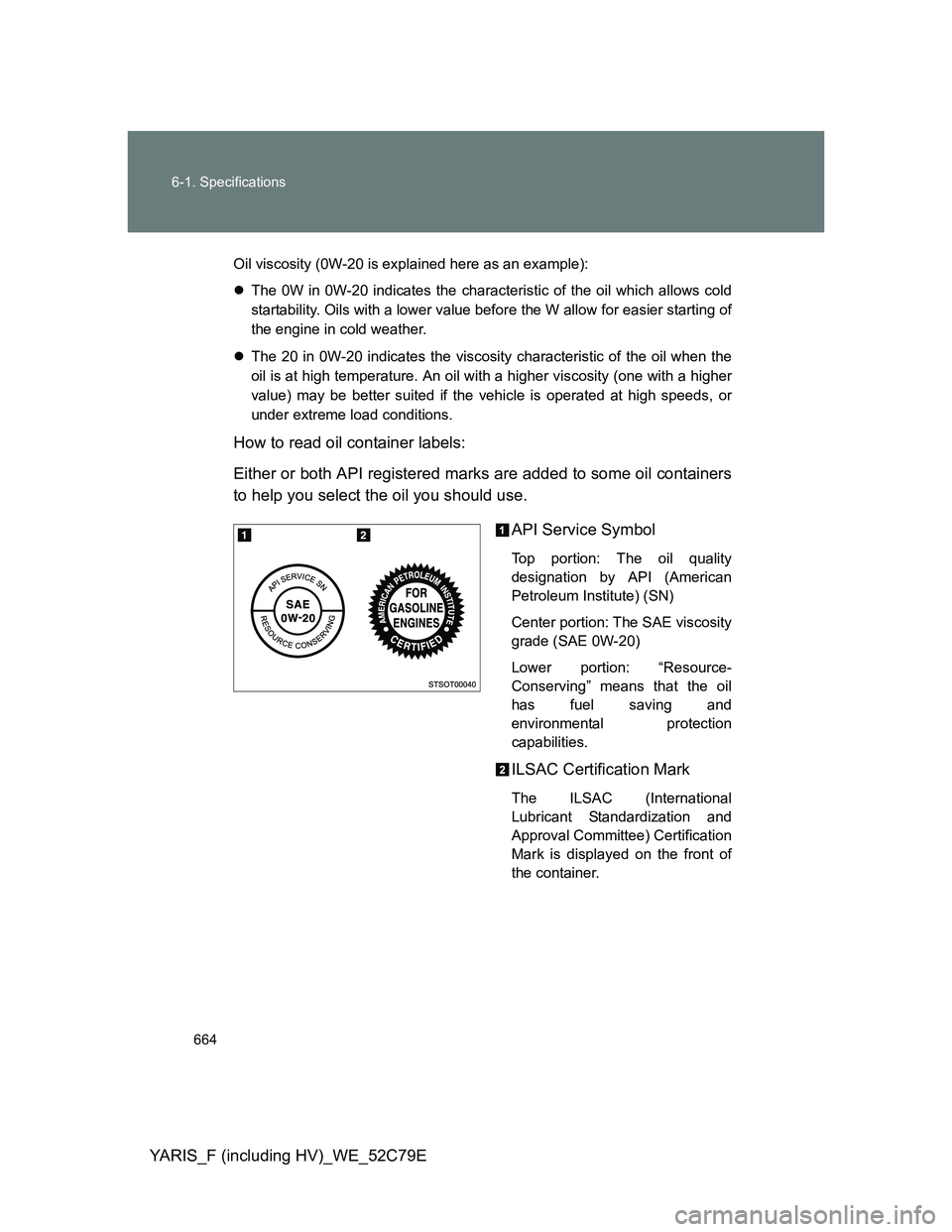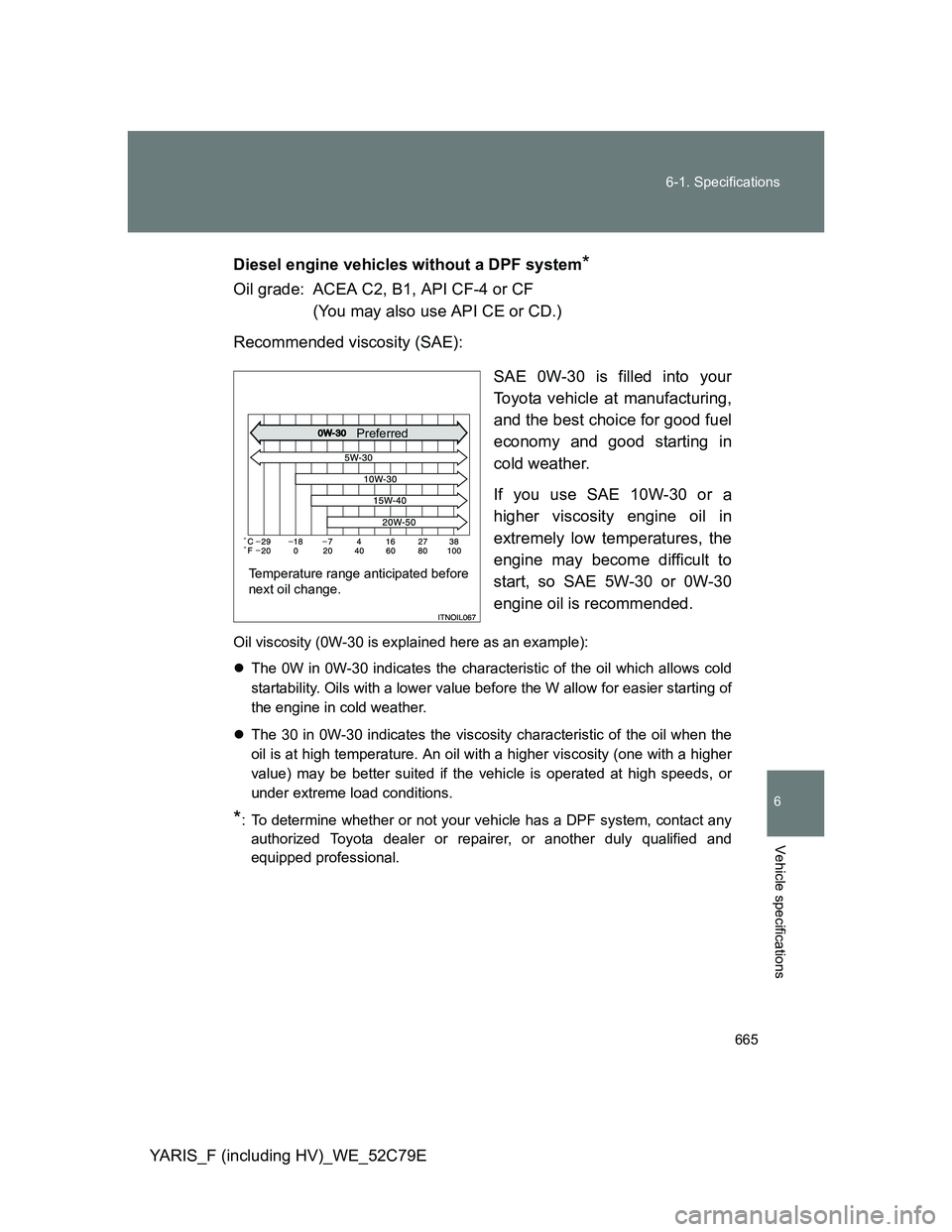Page 646 of 704
646 5-2. Steps to take in an emergency
YARIS_F (including HV)_WE_52C79E
NOTICE
When restarting the engine
Do not crank the engine before refueling and operating the priming pump.
This may damage the engine and fuel system.
Vehicles without a smart entry & start system: Do not crank the engine for
more than 30 seconds at a time. This may overheat the starter and wiring
system.
Start the engine. (P. 224, 228)
If the engine does not start after the above steps have been per-
formed, wait for 10 seconds and then try steps 3 and 5 again. If
the engine still does not start, contact any authorized Toyota
dealer or repairer, or another duly qualified and equipped profes-
sional.
After starting the engine, depress the accelerator pedal lightly until
the engine runs smoothly.
Page 647 of 704

5
647
5-2. Steps to take in an emergency
When trouble arises
YARIS_F (including HV)_WE_52C79E
If the vehicle becomes stuck
Carry out the following procedures if the tires spin or the vehicle
becomes stuck in mud, dirt or snow:
Vehicles with a hybrid transmission or a Multidrive: Stop the
engine (except hybrid vehicle) or hybrid system (hybrid
vehicle). Set the parking brake and shift the shift lever to P.
Vehicles with a multi-mode manual transmission or a man-
ual transmission: Stop the engine. Set the parking brake
and shift the shift lever to N.
Remove the mud, snow or sand from around the front
wheels.
Place wood, stones or some other material under the front
wheels to help provide traction.
Restart the engine (except hybrid vehicle) or hybrid system
(hybrid vehicle).
Vehicles with a hybrid transmission or a Multidrive: Shift the
shift lever to the D or R and carefully apply the accelerator
to free the vehicle.
Vehicles with a multi-mode manual transmission: Shift the
shift lever to E, M or R and carefully apply the accelerator to
free the vehicle.
Vehicles with a manual transmission: Shift the shift lever to
1 or R and carefully apply the accelerator to free the vehi-
cle.
Page 650 of 704

650
5-2. Steps to take in an emergency
YARIS_F (including HV)_WE_52C79E
If your vehicle has to be stopped in an emergency
Only in an emergency, such as if it becomes impossible to stop the
vehicle in the normal way, stop the vehicle using the following pro-
cedure:
Steadily step on the brake pedal with both feet and firmly
depress it.
Do not pump the brake pedal repeatedly as this will increase the
effort required to slow the vehicle.
Shift the shift lever to N.
If the shift lever is shifted to N
After slowing down, stop the vehicle in a safe place by the
road.
Stop the engine (except hybrid vehicle) or hybrid system
(hybrid vehicle).
If the shift lever cannot be shifted to N
Keep depressing the brake pedal with both feet to reduce
vehicle speed as much as possible.
Except hybrid vehicle (vehi-
cles without a smart entry &
start system): Stop the engine
by turning the engine switch to
the “ACC” position.
Hybrid vehicle (vehicles with-
out an electronic key): Stop
the hybrid system by turning
the engine switch to the “ACC”
position.
Page 651 of 704

5
651 5-2. Steps to take in an emergency
When trouble arises
YARIS_F (including HV)_WE_52C79E
CAUTION
If the engine has to be turned off while driving (except hybrid vehicle)
Power assist for the brakes and steering wheel will be lost, making the
brake pedal harder to depress and the steering wheel heavier to turn.
Decelerate as much as possible before turning off the engine.
Vehicles without a smart entry & start system: Never attempt to remove
the key, as doing so will lock the steering wheel.
If the hybrid system has to be turned off while driving (hybrid vehicle)
Power assist for the brakes and steering wheel will be lost, making the
brake pedal harder to depress and the steering wheel heavier to turn.
Decelerate as much as possible before turning off the hybrid system.
Vehicles without an electronic key: Never attempt to remove the key, as
doing so will lock the steering wheel.
Except hybrid vehicle (vehi-
cles with a smart entry & start
system): To stop the engine,
press and hold the “ENGINE
START STOP” switch for 3
consecutive seconds or more,
or press it briefly 3 times or
more in succession.
Hybrid vehicle (vehicles with
an electronic key): To stop the
hybrid system, press and hold
the “POWER” switch for 3
consecutive seconds or more,
or press it briefly 3 times or
more in succession.
Stop the vehicle in a safe place by the road.
Press and hold for 3 seconds or more,
or press briefly 3 times or more
Press and hold for 3 seconds or more,
or press briefly 3 times or more
Page 663 of 704

663 6-1. Specifications
6
Vehicle specifications
YARIS_F (including HV)_WE_52C79EEngine oil selection
“Toyota Genuine Motor Oil” is used in your Toyota vehicle. Toyota rec-
ommends the use of approved “Toyota Genuine Motor Oil”. Another
motor oil of matching quality can also be used.
Gasoline engines
Oil grade:
0W-20, 5W-20, 5W-30 and 10W-30:
API grade SL “Energy-Conserving”, SM “Energy-Conserving”, SN
“Resource-Conserving” or ILSAC multigrade engine oil
15W-40 and 20W-50:
API grade SL, SM or SN multigrade engine oil
Recommended viscosity (SAE):
SAE 0W-20 is filled into your
Toyota vehicle at manufacturing,
and the best choice for good fuel
economy and good starting in
cold weather.
If SAE 0W-20 oil is not available,
SAE 5W-30 oil may be used.
However, it should be replaced
with SAE 0W-20 at the next oil
change.
If you use SAE 10W-30 or a
higher viscosity engine oil in
extremely low temperatures, the
engine may become difficult to
start, so SAE 5W-30 or lower vis-
cosity engine oil is recom-
mended.
Temperature range anticipated before
next oil change.
Preferred
Page 664 of 704

664 6-1. Specifications
YARIS_F (including HV)_WE_52C79E
Oil viscosity (0W-20 is explained here as an example):
The 0W in 0W-20 indicates the characteristic of the oil which allows cold
startability. Oils with a lower value before the W allow for easier starting of
the engine in cold weather.
The 20 in 0W-20 indicates the viscosity characteristic of the oil when the
oil is at high temperature. An oil with a higher viscosity (one with a higher
value) may be better suited if the vehicle is operated at high speeds, or
under extreme load conditions.
How to read oil container labels:
Either or both API registered marks are added to some oil containers
to help you select the oil you should use.
API Service Symbol
Top portion: The oil quality
designation by API (American
Petroleum Institute) (SN)
Center portion: The SAE viscosity
grade (SAE 0W-20)
Lower portion: “Resource-
Conserving” means that the oil
has fuel saving and
environmental protection
capabilities.
ILSAC Certification Mark
The ILSAC (International
Lubricant Standardization and
Approval Committee) Certification
Mark is displayed on the front of
the container.
Page 665 of 704

665 6-1. Specifications
6
Vehicle specifications
YARIS_F (including HV)_WE_52C79EDiesel engine vehicles without a DPF system
*
Oil grade: ACEA C2, B1, API CF-4 or CF
(You may also use API CE or CD.)
Recommended viscosity (SAE):
SAE 0W-30 is filled into your
Toyota vehicle at manufacturing,
and the best choice for good fuel
economy and good starting in
cold weather.
If you use SAE 10W-30 or a
higher viscosity engine oil in
extremely low temperatures, the
engine may become difficult to
start, so SAE 5W-30 or 0W-30
engine oil is recommended.
Oil viscosity (0W-30 is explained here as an example):
The 0W in 0W-30 indicates the characteristic of the oil which allows cold
startability. Oils with a lower value before the W allow for easier starting of
the engine in cold weather.
The 30 in 0W-30 indicates the viscosity characteristic of the oil when the
oil is at high temperature. An oil with a higher viscosity (one with a higher
value) may be better suited if the vehicle is operated at high speeds, or
under extreme load conditions.
*: To determine whether or not your vehicle has a DPF system, contact any
authorized Toyota dealer or repairer, or another duly qualified and
equipped professional.
Temperature range anticipated before
next oil change.
Preferred
Page 666 of 704

666 6-1. Specifications
YARIS_F (including HV)_WE_52C79EDiesel engine vehicles with a DPF system
*
Oil grade: ACEA C2
Recommended viscosity (SAE):
SAE 0W-30 is filled into your
Toyota vehicle at manufacturing,
and the best choice for good fuel
economy and good starting in
cold weather.
Oil viscosity (0W-30 is explained here as an example):
The 0W in 0W-30 indicates the characteristic of the oil which allows cold
startability. Oils with a lower value before the W allow for easier starting of
the engine in cold weather.
The 30 in 0W-30 indicates the viscosity characteristic of the oil when the
oil is at high temperature. An oil with a higher viscosity (one with a higher
value) may be better suited if the vehicle is operated at high speeds, or
under extreme load conditions.
*: To determine whether or not your vehicle has a DPF system, contact any
authorized Toyota dealer or repairer, or another duly qualified and
equipped professional.
NOTICE
Using engine oil other than ACEA C2 may damage the catalytic converter.
Temperature range anticipated before
next oil change.
Preferred